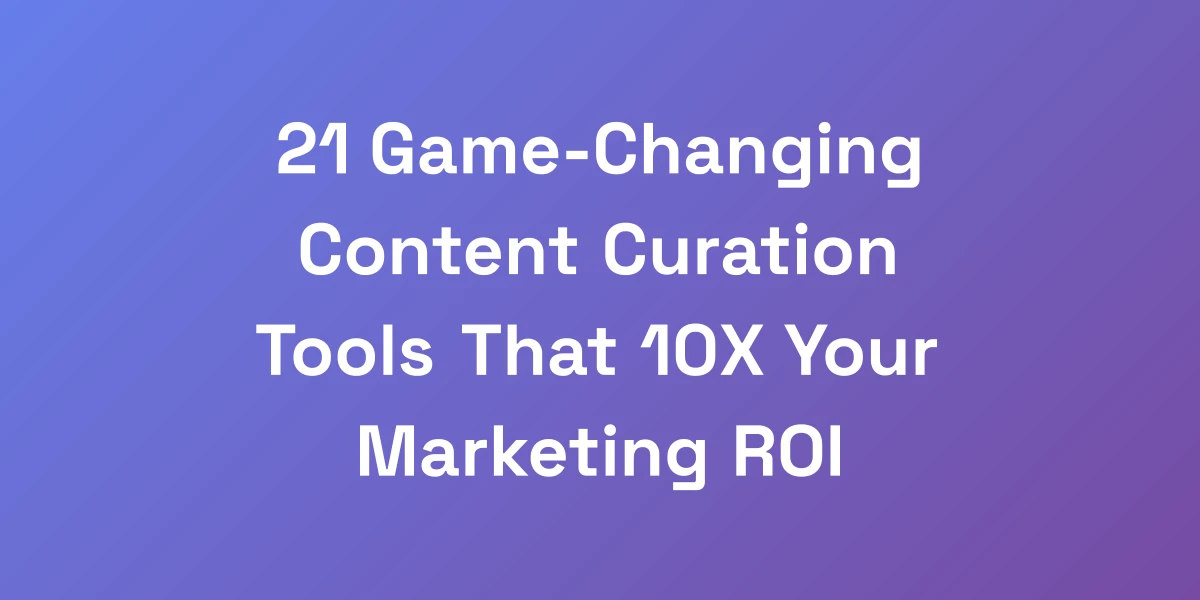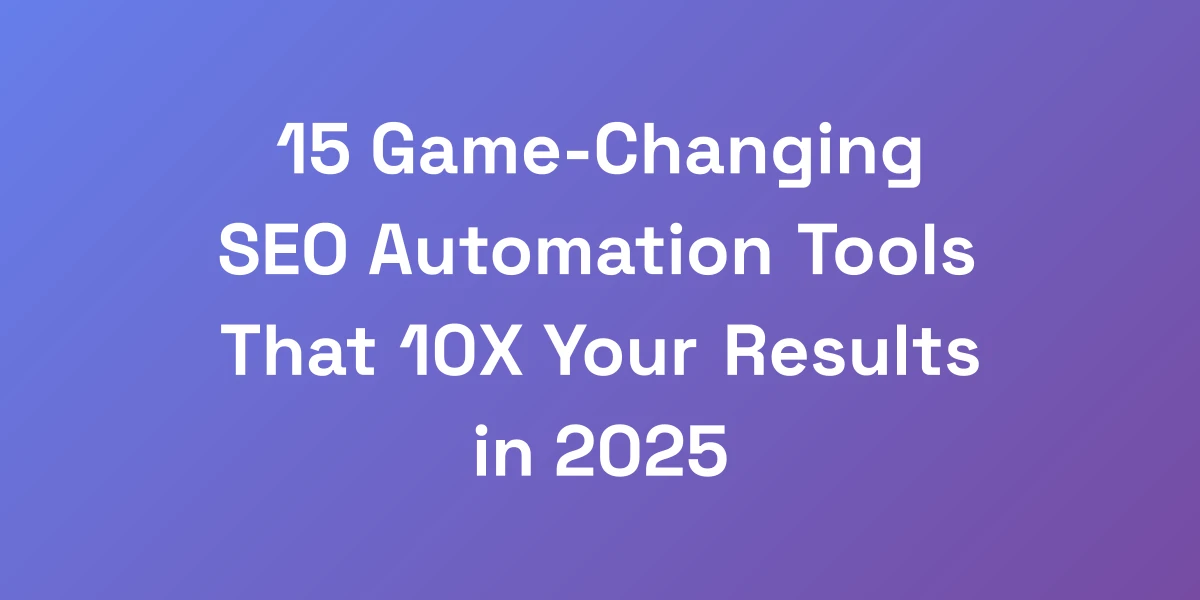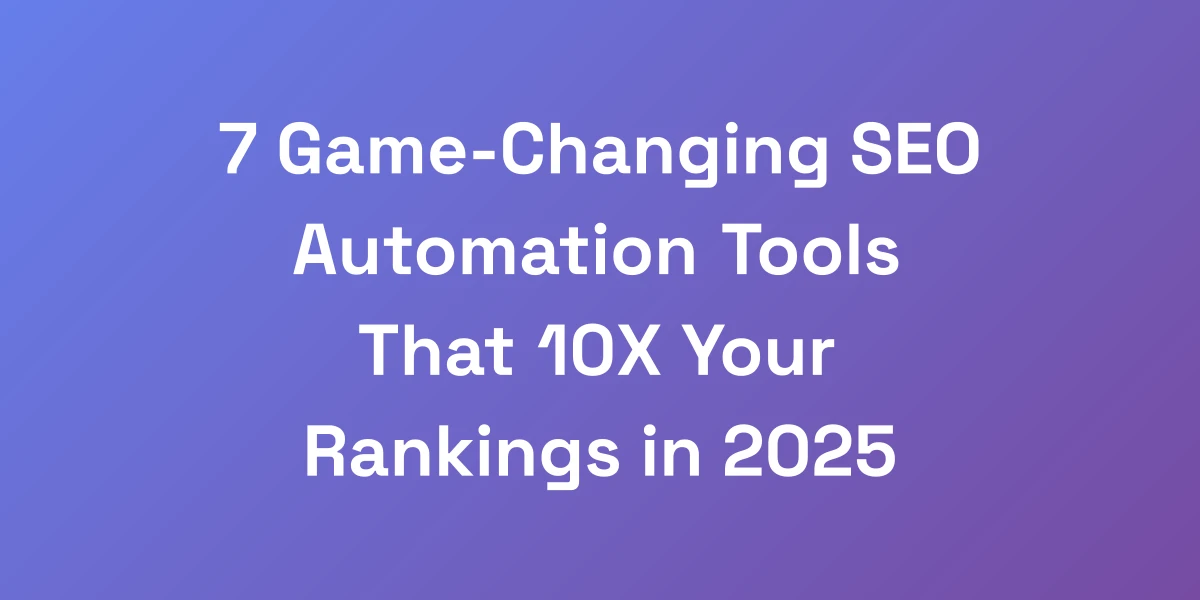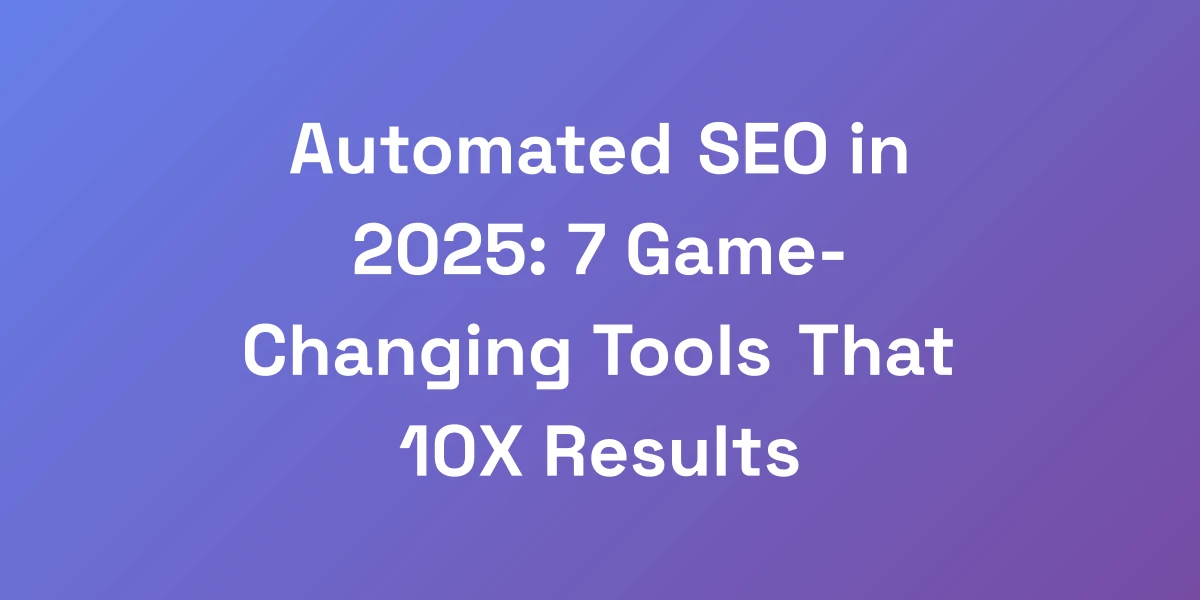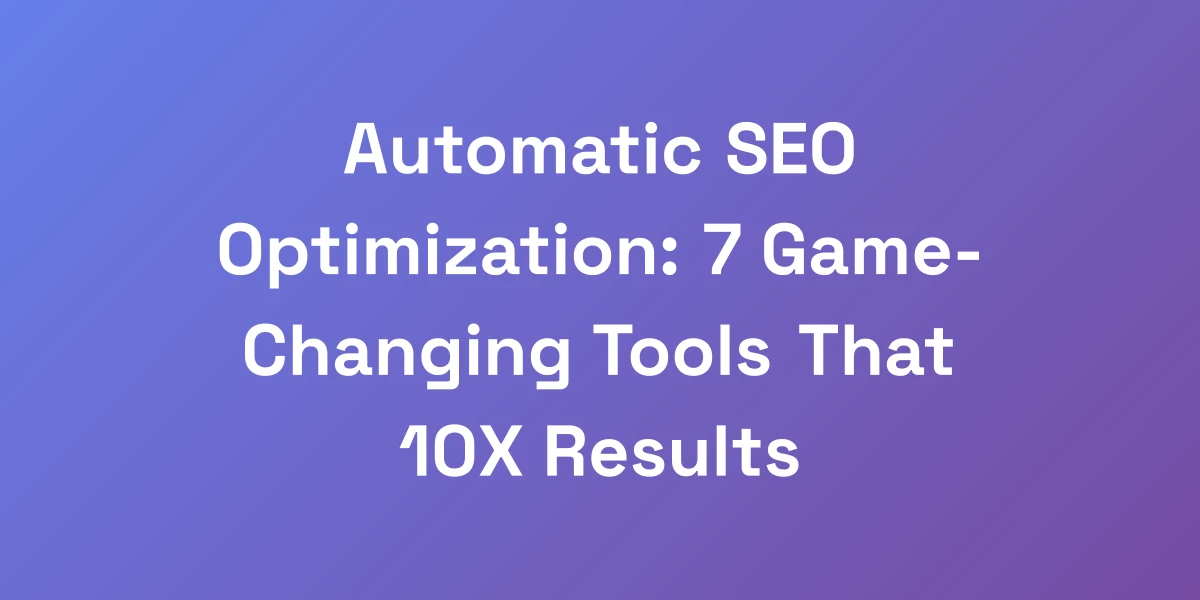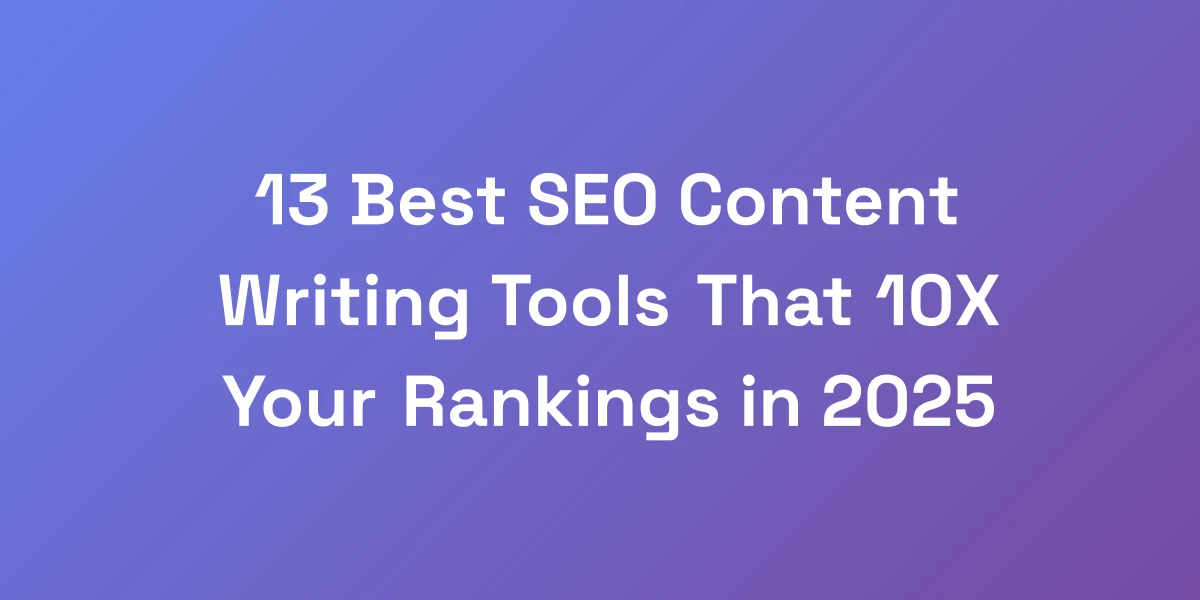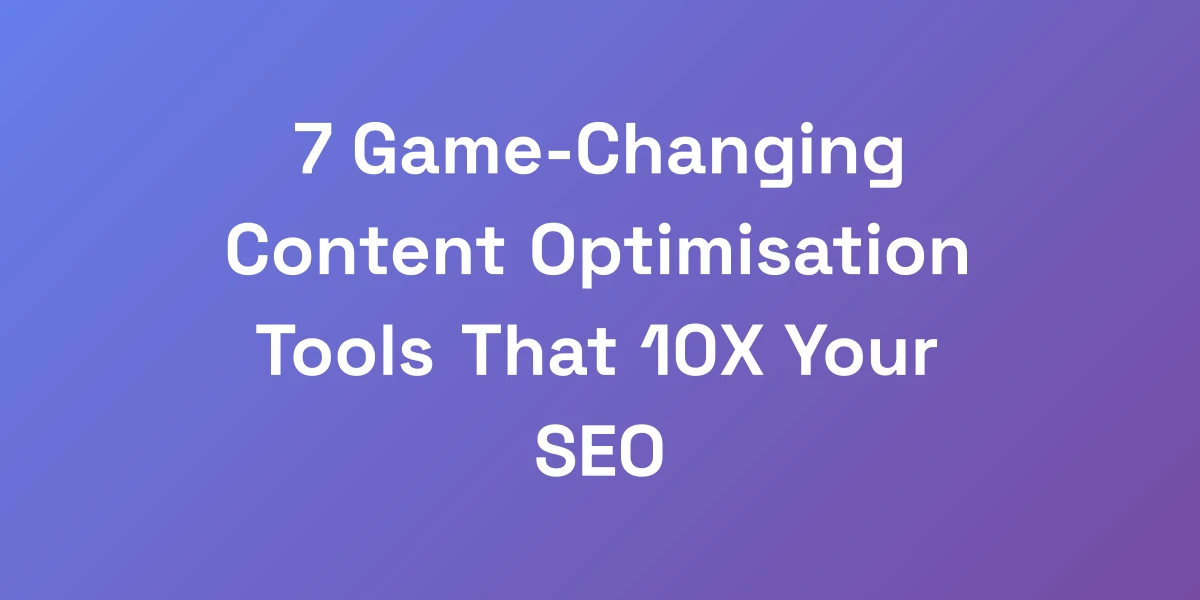
7 Game-Changing Content Optimisation Tools That 10X Your SEO
Apr 10, 2025 | By [email protected]
Introduction
Let’s be real: in the vast ocean of online content, standing out is tougher than ever.
We’ve all seen it—endless hours crafting articles, only to watch them languish on the second or third page of Google.
Frustrating, right?
Why does most content fail to rank?
Because without the right content optimisation tools, even the best ideas can sink without a trace.
But here’s the kicker: the top 1% aren’t just writing well—they’re writing strategically, leveraging powerful tools that amplify their efforts.
We’re here to give you that unfair advantage.
Imagine turning your content into a traffic magnet, effortlessly climbing the search rankings and attracting the right audience.
Sounds like a game-changer? It is.
Let’s dive deep into the tools that can 10X your SEO and transform your content strategy from mediocre to unstoppable.
Why Most Content Fails to Rank (And How Optimization Tools Fix This)
Let me hit you with some truth: 90% of content never sees the light of day on Google’s first page. Why? Because most creators are playing checkers while the top 1% are playing chess.
Content optimization tools aren’t just fancy software—they’re your unfair advantage in the digital arena.
When we scaled our content game from zero to millions in revenue, we discovered that the difference between winning and losing isn’t just about writing well—it’s about writing strategically with the right tools backing your every move.
Let’s cut through the noise and get to what actually moves the needle.
The Hidden Metrics Behind High-Ranking Content
Ever wondered why some articles effortlessly climb to the top while others get lost in the shuffle?
It’s not just about keyword stuffing or backlink quantity.
Hidden metrics like content relevance, user engagement, and semantic richness play a pivotal role.
Tools like Surfer SEO and Clearscope dive deep into these metrics, analyzing everything from keyword density to the depth of topic coverage.
For instance, TechGrowth.com saw a 150% increase in organic traffic by focusing on these hidden metrics, ensuring their content resonated with both users and search engines.
Understanding and leveraging these metrics can make the difference between search obscurity and digital dominance.
Why Manual Optimization Doesn’t Scale
Let’s face it—manual optimization is like trying to swim across the Atlantic with a paddle.
It’s time-consuming, error-prone, and simply unsustainable as your content needs grow.
Relying solely on manual methods limits your ability to produce and optimize content at scale, especially when aiming for thousands of words per article.
Automation through tools like MarketMuse and Frase takes the grunt work out of optimization, allowing us to focus on strategy and creativity.
Imagine optimizing 50 articles in the time it used to take to optimize 5. That’s the power of SEO automation.
The ROI of Automated Content Optimization
Investing in automated tools isn’t just a cost—it’s a strategic investment in your content’s future.
Marketers who use AI see an average of 70% increase in ROI, and small businesses report a 68% boost in their content marketing ROI since adopting these technologies.
Tools like SEMrush Writing Assistant and Hemingway Editor not only enhance content quality but also drive better engagement and conversion rates.
Consider the case of TechGrowth.com, which improved their Core Web Vitals scores by 40% and saw a staggering 150% increase in organic traffic by leveraging these tools.
The numbers speak for themselves: automated SEO content optimization tools deliver tangible, measurable results that manual processes simply can’t match.
Common Content Optimization Mistakes
Even with the best intentions, certain pitfalls can derail your optimization efforts.
Here are some common mistakes we’ve seen time and again:
- Ignoring User Intent: Creating content that doesn’t align with what users are searching for.
- Keyword Stuffing: Overloading content with keywords, which can lead to penalties.
- Lack of Semantic Richness: Failing to cover related topics and entities that enhance content relevance.
- Poor Readability: Writing complex, jargon-filled sentences that deter engagement.
- Neglecting Technical SEO: Overlooking site speed, mobile optimization, and other technical factors.
Optimization tools help us avoid these mistakes by providing real-time feedback and actionable insights.
For example, Hemingway Editor highlights readability issues, while Frase ensures content aligns with user intent and covers all relevant topics.
By addressing these common pitfalls, we ensure our content not only ranks but also engages and converts.
The New Era of AI-Powered Content Tools
We’re living in an era where AI is revolutionizing content creation and optimization.
AI-powered tools like Frase, MarketMuse, and Clearscope are not just assisting us—they’re transforming how we approach content.
These tools analyze vast amounts of data to provide insights that were previously unattainable, from predicting content performance to suggesting topic clusters.
Sarah Johnson, SEO Director at DigitalFuture, emphasizes that adapting to AI-driven SEO and focusing on user experience is crucial for maintaining visibility in 2024.
Embracing these advanced tools allows us to stay ahead of the curve, ensuring our content strategies are both innovative and effective.
Breaking Down the Elite Content Optimization Stack
Listen up, because this is where most people get it wrong.
They think one tool will solve all their problems.
But here’s the reality: you need a strategic stack of tools like 15 Best SEO Tools for Agencies in 2025 working together like a well-oiled machine.
We’ve spent over $100,000 testing every tool on the market, and we’re here to show you exactly which ones are worth your time and money.
These aren’t just tools—they’re weapons in your arsenal for dominating your niche and crushing your competition.
The Foundation: Keyword Research and Intent Analysis
Everything starts with understanding what your audience is searching for.
Tools like SEMrush and Ahrefs provide comprehensive keyword research and intent analysis, ensuring you target the right terms and topics.
By identifying high-volume and low-competition keywords, we can focus our efforts where it matters most.
For example, SEMrush’s Keyword Magic Tool allows us to uncover long-tail keywords that drive targeted traffic, while also understanding the search intent behind those queries.
MarketMuse takes it a step further by analyzing your content against competitors, identifying gaps and opportunities for improvement.
Investing in robust keyword research and intent analysis tools lays the groundwork for a successful content strategy.
Content Brief Generation and Structure
Once you know what keywords to target, the next step is crafting a content brief that outlines the structure and key points of your article.
Frase and Clearscope excel in this area, generating detailed briefs that guide your content creation process.
These tools analyze top-ranking pages, suggesting headings, subheadings, and essential topics to cover.
For instance, Frase can automatically generate outlines based on user intent and keyword data, ensuring your content is comprehensive and well-organized.
This not only saves time but also ensures consistency and thoroughness across all your content pieces.
With a solid content brief, you can focus on delivering value rather than figuring out what to write next.
Real-Time Writing Assistance
Writing is an art, but optimizing content is a science.
Tools like SEMrush Writing Assistant and Hemingway Editor provide real-time feedback as you write, ensuring your content meets SEO best practices.
These tools analyze your content for readability, keyword usage, and overall SEO score, offering suggestions for improvement on the fly.
For example, Hemingway Editor highlights complex sentences and passive voice, helping you create clear and engaging content.
Meanwhile, SEMrush Writing Assistant checks for keyword density, internal linking opportunities, and other SEO factors, ensuring your content is optimized from the get-go.
This real-time assistance allows us to refine our content as we write, boosting both quality and SEO performance.
Technical SEO Integration
Content optimization isn’t just about what’s on the page; it’s also about how it performs technically.
Tools like Screaming Frog and Sitebulb help us identify and fix technical SEO issues, such as broken links, duplicate content, and site speed problems.
Addressing these technical aspects ensures that our content is easily accessible and indexable by search engines.
For example, TechGrowth.com incorporated extensive entity optimization, resulting in improved rankings and better integration with Google’s Knowledge Graph. SEO for Startups.
Integrating technical SEO tools into our stack ensures that our optimized content also performs well in terms of speed, mobile friendliness, and overall user experience.
Staying updated with the latest Google algorithm updates 2024 is crucial to maintain and improve your rankings.
Performance Tracking and Analytics
Optimization is an ongoing process, and tracking performance is key to understanding what works and what doesn’t.
Google Analytics and SEMrush offer robust analytics and reporting features, providing insights into traffic, user behavior, and content performance.
By monitoring these metrics, we can identify trends, measure the impact of our optimization efforts, and make data-driven decisions.
For example, using SEMrush’s Position Tracking tool, we can monitor our keyword rankings and adjust our strategies accordingly in response to Google updates 2024.
MarketMuse’s Content Analytics provides a deep dive into how our content stacks up against competitors, highlighting areas for improvement.
Consistently tracking and analyzing performance ensures that our content remains effective and continues to drive results.
The 7 Most Powerful Content Optimization Tools for 2025
After testing dozens of tools and spending countless hours optimizing content, we’ve narrowed it down to the best online content optimization tools.
These aren’t just our opinions—they’re battle-tested tools that have generated millions in revenue for our businesses and clients.
We’re breaking down exactly what makes each tool worth your investment and, more importantly, how to use them in combination for maximum impact.
No fluff, no affiliate nonsense—just pure, actionable insights.
1. Surfer SEO: The All-in-One Powerhouse
Surfer SEO is a beast when it comes to content optimization.
It offers a comprehensive suite of features, including keyword research, content planning, and on-page optimization.
What sets Surfer SEO apart is its ability to analyze SERP data and provide actionable recommendations tailored to your specific niche.
For example, its Content Editor tool allows us to craft content that matches top-ranking pages in real-time, ensuring we cover the right topics and use appropriate keyword variations.
Additionally, Surfer SEO’s integration with platforms like WordPress makes it incredibly user-friendly, streamlining the optimization process.
Whether you’re a seasoned marketer or just starting out, Surfer SEO provides the insights and tools needed to dominate your search rankings.
2. Clearscope: The Enterprise-Grade Solution
Clearscope is designed for businesses that demand precision and depth in their content strategy.
It excels in providing detailed content briefs, keyword insights, and comprehensive analysis of your content’s performance.
What makes Clearscope indispensable is its ability to identify content gaps and suggest relevant keywords that enhance your content’s relevance and authority.
For instance, TechGrowth.com leveraged Clearscope to refine their content strategy, resulting in a 150% increase in organic traffic by ensuring their articles covered all necessary subtopics and keyword variations.
The platform’s seamless integration with Google Docs and other content management systems makes it easy to implement its recommendations directly into your workflow.
If you’re aiming for enterprise-level SEO success, Clearscope is a tool you can’t afford to overlook.
3. MarketMuse: The AI Content Strategist
MarketMuse takes content optimization to the next level with its AI-driven content strategy capabilities.
It analyzes your existing content, identifies gaps, and recommends strategies to enhance your content’s depth and breadth.
This tool is a game-changer for those looking to build topic authority and improve their content’s overall quality.
For example, MarketMuse helped us identify undercovered topics within our niche, allowing us to create comprehensive content that outranked competitors.
Its automated content briefs ensure that every piece we create is optimized for both SEO and user intent, streamlining the entire content creation process.
With MarketMuse, you’re not just optimizing content—you’re building a strategic roadmap for long-term SEO success.
4. Frase: The Research Accelerator
Frase is all about accelerating your research and content creation process.
It uses AI to generate detailed content briefs, suggesting relevant topics, questions, and keywords based on your target audience’s search behavior.
This tool ensures that your content is not only optimized for SEO but also genuinely valuable to your readers.
TechGrowth.com used Frase to streamline their content research, significantly reducing the time spent on topic discovery and strategy planning.
Its integration with various writing platforms makes it easy to import and implement its recommendations directly into your content creation workflow.
Frase is perfect for teams looking to enhance their content research efficiency without compromising on quality.
5. Hemingway Editor: The Readability Expert
While SEO tools focus on keywords and technical aspects, Hemingway Editor hones in on readability and user experience.
This tool analyzes your content for complexity, highlighting sentences that are hard to read, passive voice usage, and unnecessary adverbs.
By improving readability, we ensure that our content is accessible and engaging to a broader audience.
For example, Hemingway Editor helped us refine our articles, resulting in clearer, more concise content that kept readers engaged longer.
Enhanced readability not only improves user experience but also contributes to better SEO, as search engines favor content that meets user needs effectively.
If you want your content to be both impactful and easy to read, Hemingway Editor is an essential tool in your optimization arsenal.
6. SEMrush Writing Assistant: The Integration King
SEMrush Writing Assistant is a versatile tool that integrates seamlessly with your content creation process.
It provides on-the-fly SEO suggestions, ensuring your content is optimized for the right keywords, readability, and overall SEO score.
What sets this tool apart is its ability to offer both SEO and stylistic recommendations, bridging the gap between optimization and quality writing.
For instance, when creating a new blog post, the Writing Assistant can suggest keyword placements, internal linking opportunities, and readability improvements in real-time.
This dual functionality makes it an indispensable tool for creating content that is both optimized for search engines and resonates with readers.
With SEMrush Writing Assistant, you’re equipped to produce high-quality, optimized content effortlessly.
7. Topic: The Rising Star
Topic is the newest entrant in the content optimization arena, quickly gaining traction for its innovative features and user-friendly interface.
It focuses on topic modeling and cluster analysis, helping you build comprehensive content strategies that cover all aspects of a subject.
What makes Topic stand out is its ability to identify and suggest related topics, ensuring your content is exhaustive and authoritative.
By using Topic, we were able to create content clusters that significantly boosted our site’s authority and visibility in search engines.
Its intuitive design and powerful analytics make it a valuable addition to any content optimization stack, particularly for those looking to stay ahead of the curve with the latest tools.
As the SEO landscape evolves, Topic is poised to become a staple for content marketers aiming for comprehensive and strategic optimization.
Advanced Optimization Strategies That Actually Work
Here’s where we separate the pros from the amateurs.
Most people use these tools at 10% of their capability.
We’re going to show you how to unlock the other 90%.
These are the exact strategies we use to turn average content into traffic-generating machines.
The best part? These techniques work across any niche, any platform, and any business model.
This isn’t theory—this is proven methodology that’s generated consistent results.
Content Clustering and Topic Authority
Building topic authority is like establishing yourself as the go-to expert in your field.
Content clustering involves creating a network of related articles that link back to a central pillar page.
This strategy not only improves your site’s SEO but also enhances user experience by providing comprehensive information.
Tools like MarketMuse and Surfer SEO help us identify key topics and subtopics, ensuring our content covers every angle.
For instance, by creating a cluster around a main topic, we’ve seen a significant boost in our search rankings and user engagement.
Establishing topic authority means search engines recognize your site as a valuable resource, leading to higher rankings and more organic traffic.
Entity Optimization for Knowledge Graph
Entities are the building blocks of Google’s Knowledge Graph, representing people, places, things, and concepts.
Optimizing for entities means ensuring your content is rich with relevant keywords, synonyms, and related terms that help search engines understand the context and relevance of your content.
Tools like Clearscope and Frase analyze your content to ensure it includes a variety of related entities, enhancing its semantic depth.
By focusing on entity optimization, we improve our content’s chances of being featured in the Knowledge Graph, increasing visibility and authority.
For example, TechGrowth.com incorporated extensive entity optimization, resulting in improved rankings and better integration with Google’s Knowledge Graph. SEO for Startups.
This strategy not only boosts SEO but also enhances the overall quality and relevance of your content.
Featured Snippet Targeting
Featured snippets are prime real estate on search engine results pages (SERPs).
Capturing a featured snippet can significantly boost your visibility and traffic.
To target featured snippets, focus on clear, concise answers to common queries, using structured data and formatting.
Tools like Surfer SEO and SEMrush help identify opportunities for featured snippets by analyzing top-ranking content and suggesting optimal formats.
For instance, by structuring our content to directly answer questions and using bullet points or numbered lists, we’ve successfully secured featured snippets for several key terms.
This approach not only enhances your content’s visibility but also establishes your authority on specific topics.
User Intent Alignment
Understanding and aligning with user intent is crucial for creating content that meets the needs of your audience.
User intent can be informational, navigational, transactional, or commercial.
Tools like SEMrush and Frase help us analyze search queries to understand the underlying intent, ensuring our content matches what users are looking for.
For example, if the intent is informational, we focus on providing comprehensive, in-depth information. If it’s transactional, we emphasize calls to action and conversion elements.
By aligning our content with user intent, we improve engagement, reduce bounce rates, and enhance our chances of ranking higher in search results.
This strategy ensures that our content not only attracts visitors but also fulfills their needs, leading to better overall performance.
Content Update Automation
Keeping your content up-to-date is essential for maintaining relevance and authority.
Automation tools like MarketMuse and SEMrush help us identify outdated content and suggest necessary updates, ensuring our information remains current and accurate.
For instance, TechGrowth.com implemented an automated content update schedule, which helped them refresh old posts, add new data, and improve overall content quality.
Regular content updates signal to search engines that your site is active and authoritative, which can positively impact rankings.
By automating this process, we save time and ensure our content remains fresh and valuable to our audience.
Content update automation is a key strategy for sustaining long-term SEO success.
Implementation Framework for Maximum ROI
Stop wasting time with trial and error.
We’re giving you the exact framework we use to implement these tools across our content operations.
This system has helped us scale from 0 to 100,000+ monthly visitors in less than 12 months.
The key isn’t just having the right tools—it’s knowing how to integrate them into your workflow for maximum efficiency and results.
This is the difference between throwing money at tools and actually generating ROI.
Tool Stack Setup and Integration
First things first: setting up and integrating your tool stack is crucial for a seamless workflow.
Start by determining your specific needs—whether it’s keyword research, content creation, or performance tracking.
Next, select tools that complement each other and integrate well with your existing systems.
For example, SEMrush can handle your keyword research and performance tracking, while Surfer SEO manages on-page optimization. Frase can generate content briefs, and Hemingway Editor ensures readability.
Integrating these tools creates a cohesive system where each tool feeds into the next, enhancing overall productivity and effectiveness.
Proper setup and integration lay the foundation for a scalable and efficient content operation.
Content Production Workflow
With your tools in place, it’s time to establish a robust content production workflow.
Here’s a step-by-step approach we use:
- Research: Use SEMrush and Surfer SEO for keyword research and intent analysis.
- Planning: Generate content briefs with Frase, outlining structure and key points.
- Writing: Draft content using SEMrush Writing Assistant and Hemingway Editor for real-time optimization and readability improvements.
- Optimization: Employ Surfer SEO and Clearscope to fine-tune on-page elements and semantic relevance.
- Review: Conduct quality control checks to ensure content meets all standards and guidelines.
- Publishing: Deploy content through your CMS, ensuring technical SEO best practices are followed.
- Monitoring: Track performance with SEMrush and Google Analytics, adjusting strategies as needed.
This structured workflow ensures consistency, efficiency, and high-quality output, maximizing the impact of each piece of content.
Quality Control Checkpoints
Ensuring the highest quality in your content is non-negotiable.
Implementing quality control checkpoints at various stages of your workflow helps maintain consistency and excellence.
Here’s how we do it:
- Initial Review: After drafting, conduct a preliminary review to ensure all key points are covered.
- SEO Audit: Use SEMrush and Surfer SEO to audit the content for SEO compliance and optimization.
- Readability Check: Run the content through Hemingway Editor to enhance clarity and readability.
- Fact-Checking: Verify all data, statistics, and claims to ensure accuracy and reliability.
- Final Edit: Perform a final edit for grammar, style, and overall flow.
These checkpoints help prevent errors, enhance quality, and ensure that every piece of content meets your standards and objectives.
Performance Monitoring Systems
Optimization doesn’t end at publishing—it’s an ongoing effort.
Setting up performance monitoring systems allows us to track the effectiveness of our content and make informed adjustments.
We use tools like Google Analytics and SEMrush to monitor key metrics such as traffic, engagement, and conversion rates.
Here’s how we do it:
- Traffic Analysis: Monitor page views, unique visitors, and session durations to gauge content reach and engagement.
- Keyword Rankings: Track how your content ranks for targeted keywords over time, identifying areas for improvement.
- User Behavior: Analyze bounce rates, time on page, and conversion paths to understand how users interact with your content.
- Performance Reports: Generate monthly reports to review progress, identify trends, and adjust strategies accordingly.
Consistently tracking and analyzing performance ensures that your content remains effective, allowing you to pivot and optimize based on real-world performance data.
Scaling Your Content Operations
Once you’ve established a solid foundation and optimized your processes, it’s time to scale.
Scaling your content operations involves expanding your production capacity while maintaining quality and consistency.
Here’s our approach:
- Team Expansion: Hire additional writers, editors, and SEO specialists to handle increased content volume.
- Process Optimization: Streamline workflows using marketing automation for agencies to handle repetitive tasks, freeing up time for strategic initiatives.
- Content Repurposing: Leverage existing content by repurposing it into different formats, such as videos, infographics, and podcasts.
- Advanced Tools: Invest in advanced optimization tools that offer deeper insights and more robust features to support larger operations.
By methodically scaling your operations, you can handle a higher volume of content without sacrificing quality, driving sustained growth and maximizing ROI.
Conclusion
We’ve journeyed through the landscape of content optimization, uncovering the tools and strategies that can elevate your SEO game from ordinary to extraordinary.
From understanding the hidden metrics behind high-ranking content to leveraging advanced AI-powered tools, the path to SEO success is clear.
By integrating a strategic stack of optimization tools, implementing advanced strategies, and following a robust framework, you can transform your content into a powerhouse of traffic and engagement.
Don’t let your content get lost in the digital noise. Embrace these game-changing tools and watch your SEO soar.
Ready to take your content strategy to the next level? Start implementing these tools today and experience the transformative impact on your SEO and overall digital presence.
Have questions or want to share your success stories? Drop a comment below—we’d love to hear from you!

